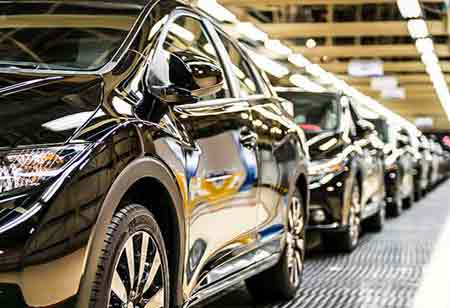THANK YOU FOR SUBSCRIBING
THANK YOU FOR SUBSCRIBING
Be first to read the latest tech news, Industry Leader's Insights, and CIO interviews of medium and large enterprises exclusively from Auto Tech Outlook

By
Auto Tech Outlook | Sunday, May 22, 2022
Stay ahead of the industry with exclusive feature stories on the top companies, expert insights and the latest news delivered straight to your inbox. Subscribe today.
Advanced infotainment systems, Safety, autonomous driving features, and electrification fuel the demand for automotive sensors.
FREMONT, CA: We are at a momentous, palpable turning point in the automotive industry. There’s tremendous pressure on automakers to innovate and reconsider vehicle usage. Not just do they required to fulfill consumer demand, but they must also continue with varying Safety and environmental regulations. Thus, automakers are growing the number of sensors employed within and around vehicles to give their buyers the best Safety and functionality, which requires sensor manufacturers to miniaturize and enhance previous technologies.
1. Infotainment systems are turning more innovative
The rate of technology acceptance within vehicles to incorporate the latest infotainment characteristics and trends is integral. The user experience is turning into much more than just a drive.
The number of displays utilized in a typical vehicle is growing – from reconfigurable instrument clusters to center consoles to passenger enjoyment. Simultaneously, display quality is growing because of larger screens with better resolutions and higher brightness levels. E-mirrors for rear & side views are also turning more normal, as are wireless charging modules and extra media hubs.
Cars are initiating to feel like stable extensions of smartphones, with clients awaiting aesthetically clean touch surface patterns, which prompts extra integrated circuits (ICs) like inductance-to-digital converter (LDC) sensors that allow a “force touch” attribute on surfaces that do not screen, with the ability to detect the amount of force applied.
3D Hall-effect sensors allow position detection in e-shifters (gear shifters) and infotainment management of joysticks and knobs, often combined with touch and UI features around center consoles.
Since temperature sensors play an important role in avoiding harm to circuits caused by overheating, automakers are increasing the number of temperature sensors utilized on a regular PCB and prioritizing reliability and accuracy during product selection. Positioning temperature sensors in system hot spots like the power supply, microcontroller, or backlight LED display allows for keeping these elements within their recommended operating conditions, which allows the infotainment system to provide the performance and authenticity expected by consumers.
2. Extra Safety and autonomous driving characteristics
Not every car is made equal, particularly when customized for specific markets. But government regulations are approaching the standard safety characteristic gap to confirm consumer safety.
Automakers require sensors to sense the environment within and around a vehicle to count these safety characteristics of low- and mid-tier models.
Advanced safety characteristics are a part of advanced driver assistance systems (ADAS). Originally known for cruise control, ADAS has morphed into so much more, getting sensors on vehicles to a completely new level to support features such as in-cabin monitoring, blind-spot detection, lane departure warning, and parking assistance – even the latest autonomous driving technology.
Autonomous driving functions cannot occur without cameras and ultrasonic, radar, or LiDAR sensors on edge to sense the environment around a vehicle. As greater automakers race to achieve higher levels of autonomous driving, increasing the number of sensors is inevitable.
One general need in functional Safety is redundancy. Automakers are fastly approving sensors for safety-critical control systems to meet redundancy requirements, increasing the number of sensors. Sensor manufacturers such as TI have observed this trend and concentrated on making it simpler for engineers to find and utilize sensors in designs targeted to satisfy functional safety standards or competitively distinguished safer systems.
3. A rise in electrification
Several countries have declared target dates and pledges concerning electric vehicle sales.
The information on each country’s target may vary. Still, the collective goal is to eliminate internal combustion engine (ICE) vehicles over time with directions and incentives like tax breaks or subsidies.
Compared to ICE vehicles, EVs have increased voltage, current, temperature, and humidity sensing requirements because large subsystems like the onboard charger, DC/DC converter, inverters, and battery-management system (BMS) all handle high voltage or currents. Each one of these systems requires close monitoring to reduce the threat of current surges, thermal runaways, and even corrosion or shorts from moisture outflow.
High sensor accuracy in these systems could convert to shorter EV charging times and prolonged battery life. For instance, more accurate temperature readings can lessen margins of error, hence avoiding the false triggering of control systems and enabling closer operation to thermal limits, throttling, or shutting down just when essential. Total accuracy when utilizing temperature sensors is akin to the sensor and surrounding components, layout techniques, and thermal conduction paths, so it’s important to remember best practices when using surface-mount temperature sensors.
 Copyright © 2025 AutoTech Outlook. All Rights Reserved | Privacy Policy | Subscribe | Sitemap | About us | Feedback Policy | Editorial Policy
Copyright © 2025 AutoTech Outlook. All Rights Reserved | Privacy Policy | Subscribe | Sitemap | About us | Feedback Policy | Editorial Policy 
However, if you would like to share the information in this article, you may use the link below:
https://www.autotechoutlookapac.com/news/automobile-sensor-boom-three-trends-nwid-1294.html




